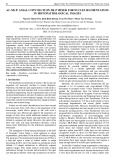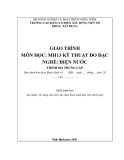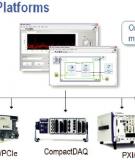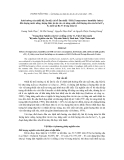
* Corresponding author.
E-mail addresses: mrm_aliha@iust.ac.ir (M. R. M. Aliha)
© 2014 Growing Science Ltd. All rights reserved.
doi: 10.5267/j.esm.2014.8.005
Engineering Solid Mechanics 2 (2014) 265-276
Contents lists available at GrowingScience
Engineering Solid Mechanics
homepage: www.GrowingScience.com/esm
Systematic design of an atmospheric data acquisition flying vehicle
telemetry system
Vahid Bohlouria, Amir Reza Kosaria and MRM Alihab*
aFaculty of New Science and Technology, University of Tehran, Iran
bWelding and Joining Research Center, School of Industrial Engineering, Iran University of Science and Technology (IUST), Narmak, 16846-13114,
Tehran, Iran
A R T I C L E I N F O A B S T R A C T
Article history:
Received March 6, 2014
Accepted 23 August 2014
Available online
24 August 2014
In this paper, we have provided hands-on experience in systematic design, implementation and
flight test of an atmospheric data acquisition flying vehicle as a standard CanSat telemetry
mission. This system is designed for launching from a rocket at a separation altitude about
1000-meter. During its flight, the reusable flying vehicle collects environmental data and
transmits it directly to the ground station. The ground station, which is implemented at a pre-
defined radio frequency band receives data and plots the respective graphs. The design
performs based on a systematic approach, in which the first step is set aside to mission and
objectives definition. In the next step, the system requirements are identified and the required
main subsystems and elements with their technical requirements will be extracted. The structure
analyses were also performed by ABAQUS software to obtain the natural frequency and the
mode shape. The wireless communications, onboard microcontroller programming, sensor
interfacing and analog to digital conversion describe the basic technologies employed in the
system implementation. This flying vehicle in comparison with the other similar ones is more
lightweight, has few interface circuits and high precision sensors. According to the flight test
outputs, low power consumption, high transmit line up to 2Km despite of limitation in TX
power and up to 10g normal acceleration withstanding are important specific characteristics of
the implemented flying system.
© 2014 Growin
g
Science Ltd. All ri
g
hts reserved.
Keywords:
Flying Vehicle
CanSat
Systematic Design
Telemetry System
1. Introduction
Flying vehicle design and development process involves identification of its requirements, listing
of tasks to accomplish and identification and allocation of required resources for its successful
execution. Generally, the life cycle of a flying mission progresses through four phases: Design,
Production, Operations and Support (Larson & Wertz, 1992). The main challenge in design procedure
of a flying vehicle is its multi-disciplinary nature. This is characterized by degrees of influences that

266
each design discipline has on the others. In this work, a telemetry system of a small satellite is
designed, fabricated and tested based on a predefined set of design requirements. CanSat is consisted
of two words, Can and Sat, which means a satellite in the size of the standard beverage can and it is
called to system used in competitions held all over the world to train the future space engineers and
get them to become familiar with aerospace activities (Nylund & Antonsen, (2007)). There are four
phases in response of system requirements, which could be considered as follows:
Mission Analysis & Feasibility study
Preliminary Design
Critical Design and Construction
Test & Modification
The Operational Requirement Document (ORD) is the basis for acquiring of System Requirement
Document (SRD). It became the main source for developing system architecture, identification of
subsystem requirements and their preliminary design. In the following sections, both system and
operation requirement and design of subsystems and implementation of atmospheric data acquisition
telemetry system are briefly described and some flight test results are presented and discussed to
demonstrate the logical proposed systematic approach (Wittmann & Hallmann, 2009).
2. System Design
According to V chart, system design including system level and the level of detail. In system level,
objective, mission, constraint, requirement and tests are discussed. In the following the key required
system design demonstrates including, the Mission Needs Statement, Operational Requirement
Document, System Technical Requirement, System Architecture, Identification of Requirement are
illustrated (Larson & Wertz, 1992).
2.1 Mission Needs Statement (MNS)
In this phase, the design performed based user needs, thus first should define the needs or requests
of customers. It is responsibility of designers to translate them to operational needs and document in
Mission Needs Statement (MNS). MNS clears that what problem is trying to solve in the program.
For this project, the MNS is as follows: The measure of atmospheric data for scientific experiments
are needed and requested. The desired system must be designed in soft drink can size and weight. It
must be autonomous and send the data of ambient pressure, humidity, temperature, GPS location and
acceleration in real time into a ground station. This system can be launch from rocket or balloon. In
addition, it must have the safe landing and must be ability of operation for 1 hour (Wasson (2006)).
2.2. Operational Requirement Document
MNS must be translated by operator into an Operational Requirement Document (ORD) that is
validated by collaboration with the users. ORD is: the system will be a small satellite analog which
all of its components must be housed inside a cylinder, 115 mm-height and 66 mm-diameter with
maximum weight of 350 grams. Albeit, the deployable subsystems and recovery system can exceed
the length of the primary structure, up to a maximum length of 230 mm. System is launched and
ejected from a rocket or a balloon. By the use of a parachute, it slowly descends back to earth
performing its mission while transmitting telemetry. The telemetry data will include the barometric
altitude, ambient humidity and temperature, GPS location and acceleration. This system must be fully
autonomous and its data sending must be real time. The system is not allowed to use dangerous
materials. The power supply must supply the systems at least 1 hour (Nylund & Antonsen (2007)).

V. Bohlouri et al. / Engineering Solid Mechanics 2 (2014)
267
2.3 System Technical Requirement
Technical requirements will be derived from ORD justification methods of these requirements are
listed in Table1.
Table1. The system technical requirement
number Requirement Justification Method
1 Maximum mass is 350 gram Inspection
2 Volume is a cylinder with 115 mm-height and 66 mm-diameter Inspection
3 Maximum exceed length is 230mm Inspection Design
Review
4 Maximum speed descent is 5 m/s Test Analysis
5 Withstand 10 g Acceleration Test Analysis
6 1 hour power Test Analysis
7 The system do not use photoelectric sensors. Inspection Design
Review
8 Maximum Rocket Altitude 1000 meter Inspection
9 Sending follows Data: Barometric altitude, ambient humidity and
temperature, GPS location and acceleration Design Review
10 Do not use pyrotechnics, flammable or dangerous material Inspection Design
Review
11 The total cost of the system cannot exceed 1000 Euros. Design Review
12 System must withstand vibration forces due to rocket launch Analysis
2.4 System Architecture
The system architecture was performed based on the operational concept. Thus, this system
architecture should be considered the following sections.
- structure and mechanism
- Recovery and Descent control
- Electrical and Electronics
- Communication and ground station
Moreover, the according to the objective, mission and requirements of the subsystems are:
‐ Electrical Power
‐ Data Handling
‐ Communication
‐ Grand station
‐ Recovery
‐ Structure and Mechanism
‐ Payload
2.5. Identification of Requirement
In this step, the technical requirements of all subsystems are derived from mission, operation and
system requirements. These requirements which are on the basis of subsystems deign are listed in
Table 2 (Eerkens et al., 2008).

268
Table 2. Telemetry system requirements
Number Structure Requirements Justification Method
1 The dimensions should be cylinder with 66 mm (diameter) and 115 mm (Height). Inspection
2 There must be no protrusions until the system release and deployment from the rocket payload. Inspection
Design Review
3 No electronic/mechanical control is employed to push the CanSat out of payload. Inspection
Design Review
4 CanSat must withstand vibration forces due to rocket launch. Analysis
5 The structure shall support electronics during flight and Impact. Test Analysis
6 The structure must provide required space for placement of all subsystems excluded parachute. Design Review
Recovery System Requirements
1 The average descent rate of system after deployment shall be lower than 5 m/s. Test Analysis
2 The attachment of the recovery system must withstand 10 G in the moment of its deployment. Test Analysis
3 The parachute and its paraphernalia must be fitted in cylindrical place with maximum dimension of
66mm * 115mm (the allowable parachute space) Inspection
4 The attachment of recovery system must be fixed directly to the primary structure. Inspection
5 The parachute must be fully opened after 8 seconds. Analysis Test
Data Handling Subsystem Requirements
1 Numbers of components which use UART or SPI as interfaces with microcontroller should be
compatible with number of UART or SPI interfaces in microcontroller. Design Review
2 The telemetry packets must be transmitted at rate of 1Hz Test
3 Microcontroller should be able to handle all sensor data. Test Analysis
4 Microcontroller should store sensor data on-board memory. Test Analysis
5 Data transmission must be terminated after landing detected. Design Review
Power subsystem Requirements
1 Operating voltage range for battery and regulator must be compatible with sensor & other electrical
components.
Test Design
Review
2 All components should be supplied with a unique battery. Inspection
3 The battery voltage must be higher than 3.3V. Design Review
Communication Subsystem Requirements
1 The configuration of communication subsystem must include the transmitter and receiver. Inspection Design
Review
2 Minimum transmitting range of data should be 1000 m. Analysis Test
3 Maximum emission power must be equal or lower than the allowable level of 2 to 5 Watt Analysis Design
Review
4 The range of frequency is between 2 – 2.4 GHz Analysis Design
Review
5 Coding of Data Analysis Test
Payload Subsystem Requirements
1 Humidity sensor must have a range of at least 20% to 90% (Worst case). Test Design
Review
2 Pressure sensor must have a range of at least 60 kPa to 90 kPa. Test Design
Review
3 Temperature sensor must have a range of at least -10ºC to +50ºC. Test Design
Review
Ground Station Requirements
1 Connect with transponder Test Design Review
2 Receive, Amplify and plot data Test Design Review
3 Decoding of Data Test Design Review
3. Subsystem Design
In detail level, the subsystems and elements are discussed and designed. Designing phase, leads to
preliminary and critical designs, fabrication phase which consists of simulations, part procurement,
testing electronic devices, subsystem fabrication and test and system assembly. The last phase

i
s
3
t
e
t
p
p
i
r
t
3
r
a
a
s
m
s
r
Z
s
F
(
3
s
m
i
ncludes th
e
s
atellite na
m
3
.1. Electri
c
The ele
c
t
hree lithiu
m
e
mployed t
o
t
he voltage
p
recautions
p
art from o
t
i
s presente
d
r
esults sho
w
t
han one ho
u
3
.2.Commu
n
The co
m
r
eceiving t
h
a
nd the di
s
a
llowed fre
q
s
howed tha
t
m
illi Watt
R
s
ight. For
r
eceived da
t
Z
igBee m
o
s
pecificatio
n
- Freque
n
maxim
u
- Data C
- Maxi
m
- Maxi
m
- Maxi
m
F
or using t
h
(
Moghadda
m
3
.3.Data H
a
The dat
s
ubsystems
,
m
icrocontr
o
e
final ope
r
m
ely subsy
s
c
al Power
S
c
trical pow
e
m
polymer
o
provide t
h
drops, cau
s
have been
t
her parts a
n
d
in figure
w
ed that th
i
u
r.
n
ication su
b
m
municatio
n
h
e sent data
s
tance bet
w
q
uency ba
n
t
a 2.4 GH
z
R
F power
c
security is
t
a is plotte
d
o
dule is u
s
n
s:
n
cy range
u
m range o
oding
m
um RF po
w
m
um emissi
o
m
um bandw
i
h
e ZigBee
m
m
et al. (20
a
ndling Su
b
a handlin
g
,
collect da
t
o
ller and S
D
r
ational tes
t
s
tems and e
l
S
ubsystem
e
r subsyste
m
battery cel
l
h
e required
p
s
ed by cons
u
considere
d
n
d using s
o
1 that pow
i
s pack co
u
b
system
n
subsyste
m
in the gro
u
w
een the tr
a
n
d in Iran
i
z
module,
u
c
an be use
d
sues, the
d
d
in MATL
A
s
ed for d
a
used for
f 2000 met
e
w
er: 1 watt
o
n level: 10
0
i
dth (5dB):
m
odule the
t
13)).
b
system
g
subsyste
m
t
a and send
D
card use
d
V. Bohlouri et al.
t
s and eval
u
l
ements
b
as
m
should p
r
l
s of 3.7 V
p
ower and
v
u
ming too
m
d
. These pr
e
o
me capaci
t
er subsyst
e
u
ld provide
Fig.1. Pow
m
should
s
u
n
d
station.
a
nsmitter
a
i
s about 2.
4
u
sing 5 db
a
d
to transm
i
d
ata is cod
e
A
B softwar
e
a
ta transm
i
data trans
m
e
r.
0
milli Wat
t
5
MHZ
t
ransmitter
f
m
has bee
n
it to the c
o
d
to save da
t
Battry
.
/ Engineering Solid
M
u
ations. In
s
ed on Lars
o
r
ovide ade
q
and 1000
v
oltages o
n
m
uch powe
e
cautions i
n
t
or filters t
o
e
m consists
the syste
m
w
er subsyste
m
s
end onlin
e
Here, the
R
a
nd receiv
e
4
GHz at
m
a
ntennas, i
n
i
t data to a
e
d then tra
n
e
after dec
o
i
ssion. Co
m
m
ission/rec
e
t
f
ollows the
n
use
d
to
o
mmunicati
o
t
a. An 18f
s
Regulator
M
echanics 2 (2014)
the next s
e
o
n and Wer
t
q
uate powe
r
mA.h, alo
n
a bus con
n
r by high p
n
clude sep
a
o
avoid noi
s
of 3 parts
,
m
with suffi
c
m
structure
e
data, col
R
F power,
f
r should
b
m
aximum
R
n
transmitt
e
receiver, p
l
n
smitte
d
to
o
ding. ZigB
m
municati
o
e
ption is
2
IEEE 802.
1
manage
o
o
n subsyst
e
s
eries PIC
m
Filter
e
ction we i
l
t
z (1992).
r
for at lea
s
n
g with 2 r
e
n
ected to ea
c
o
wer cons
u
a
rating the
h
s
e. The po
w
battery, r
e
c
ient and r
e
l
ected by
t
f
requency r
e taken in
t
R
F power o
f
e
r and rece
i
l
aced as fa
r
a predefi
n
ees are co
m
n subsyst
e
2
400-2500
1
5.4-compl
i
o
f connect
i
e
m. This su
b
m
icrocontr
o
l
lustrate th
e
s
t one hou
r
e
gulator IC
c
h subsyste
m
u
ming parts
,
h
igh powe
r
w
er subsyst
e
e
gulator an
d
e
liable po
w
t
elemetry
s
r
ange, trans
m
t
o conside
r
f 1 watt.
H
i
ver modul
e
r
as of 2 K
m
n
ed receive
r
m
municatio
n
e
m has th
e
MHz whi
c
i
ant coproc
e
i
on betwe
e
b
system co
n
o
ller has be
2
6
e
detail of
a
r
. A pack o
s
have bee
n
m
. To avoi
d
,
some extr
a
r
consumin
g
e
m structur
e
d
filter. Th
e
w
er for mor
e
s
ystem, an
d
m
ission rat
e
r
ations. Th
e
H
ere the te
s
e
s, with 10
0
m
in line o
r
node. Th
e
n
module.
A
e
followin
g
c
h support
s
e
ssor
e
n differe
n
n
sists of th
e
en used du
e
6
9
a
f
n
d
a
g
e
e
e
d
e
e
s
t
0
f
e
A
g
s
n
t
e
e




![Giáo trình đo lường nhiệt: Môn học [tên môn học]](https://cdn.tailieu.vn/images/document/thumbnail/2012/20120905/dacnac/135x160/1131346788003.jpg)





![Mạch đo và khống chế nhiệt độ P3: Đề tài [Mới nhất]](https://cdn.tailieu.vn/images/document/thumbnail/2010/20100922/goixanh/135x160/mach_do_va_khong_che_nhiet_do_p3_5214.jpg)








![Ngân hàng trắc nghiệm Kỹ thuật lạnh ứng dụng: Đề cương [chuẩn nhất]](https://cdn.tailieu.vn/images/document/thumbnail/2025/20251007/kimphuong1001/135x160/25391759827353.jpg)






